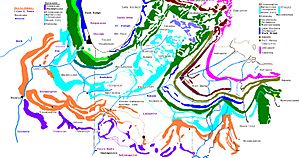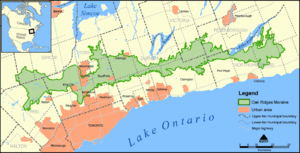List of glacial moraines facts for kids
Have you ever wondered what happens when giant sheets of ice, called glaciers, melt and move? They leave behind amazing piles of rock and dirt called moraines! Think of a moraine as a giant, natural bulldozer pushing and dropping material as it slowly moves. When the ice melts, all that stuff is left behind, forming hills, ridges, or even long, wavy lines on the land.
Moraines are like clues that tell us where glaciers used to be and how they moved. They are made of a mix of rocks, sand, and clay that the glacier picked up. Scientists study moraines to learn about Earth's past climate and how much ice covered the land long ago. This article lists some of the most well-known moraines around the world, grouped by continent and sometimes by the water systems they are near.
Contents
- North America
- Europe
- Antarctica
- South America
North America
North America has many moraines, especially in areas that were once covered by huge glaciers during the last Ice Age.
Moraines of the Great Lakes Region
The Great Lakes were carved out by glaciers, and as these glaciers melted, they left behind many moraines around the lakes.
Lake Ontario Basin
Some moraines found near Lake Ontario include:
- Oak Ridge
- Alden
- Buffalo
- Niagara Falls
- Forest
- Gowanda
- Hamburg
- Marilla
- Pembroke
- Batavia
- Barre
- Alboin
Lake Erie Basin
|
|
|
Lake Huron Basin
The area around Lake Huron also has many moraines, showing the path of ancient glaciers. Some of these include:
- Port Huron
- Chesanings
- West Haven
- Henderson
- Owosso
- Flint
- Otisville
- St. Johns
- Fowler
- Lyons
- Tawas
- Alden
Saginaw Lobe Moraines
The Saginaw lobe was a part of the glacier that moved into the Saginaw Bay area. It left behind moraines like:
- Charlotte
- Tekonsha
- Kalamazoo
- Sturgis
- Lagrange
- Middlebury
- New Paris
- Bremen
- Maxinkuckee
Interlobate ‘thumb’ of Michigan Moraines
This area, often called the "thumb" of Michigan, has moraines that formed between different parts (lobes) of the glacier. These include:
- Port Huron
- Portland
- Lyons
- Fowler
- Imlay and Goodland
- Otter Lake (St. Johns)
- Otisville
- Deanville
- Mayville
- Owosso
- Yale
- St. Juniata
Lake Michigan Basin
The Lake Michigan area is home to several important moraines, including:
|
|
|
Lake Superior Basin
The region around Lake Superior has moraines that show the movement of glaciers in the northern parts of North America. These include:
|
|
|
Moraines of Quebec and Ontario, Canada
Canada also has many significant moraines, especially in the eastern provinces.
- Oak Ridges – Ontario
- Trafalgar – Ontario
- Waterloo – Ontario
- Dixville – Quebec
- Cherry River–East-Angus – Quebec
- Ulverton-Tingwick – Quebec
Moraines of the Maritimes of Canada and Northeastern United States
The coastal areas of eastern Canada and the northeastern U.S. have moraines that often form islands or peninsulas.
- Cape Cod - Massachusetts
- North Shore (Long Island)
- Harbor Hill moraine - Long Island, New York
- Hammonasset Beach State Park
Moraines of Western Canada
Moraines of the Great Plains of the United States
Moraines of the U.S. and Canadian Rocky Mountains
Europe
Europe also has many moraines, especially in areas that were covered by glaciers in the past, like Scandinavia and parts of Germany and Italy.
- Lüneburg Heath – Germany
- Rogen moraine – Sweden, Norway
- Pulju moraine – Finland
- Salpausselkä – Finland
- Sevetti moraine – Finland
- Trollgarden – Norway
- Veiki moraine – Sweden, Norway
- Raet - Norway, Sweden, Finland
- La Serra morainic amphitheater of Ivrea - Piedmont, Italy
Antarctica
Antarctica is still largely covered by ice, but even there, scientists find moraines that show how glaciers have moved and changed over time.
|
Queen Maud Land
|
Ross Dependency
|
South America
South America, particularly the Andes mountains and Patagonia, also has moraines from past and present glaciers.
|



